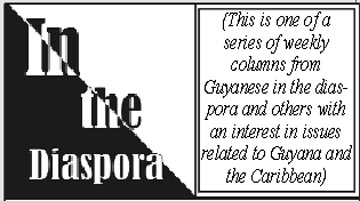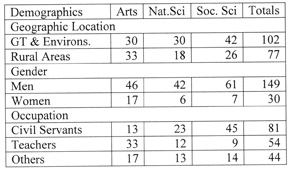By Harold Drayton
Harold A. Drayton served as the First Deputy Vice-Chancellor (1963-1964) at the University of Guyana, and as Professor and Head of the Department of Biology. He now lives in Pennsylvania
.
I thank our University for the kind invitation to contribute to the 50th Anniversary celebration of the establishment of the University of Guyana; and my very first words must be to congratulate all my countrymen and women for the unstinting support that they have given, to enable our National University to survive, and to develop, over these past five decades. Congrats are due also, to the academic, administrative and support staff of UG, without whose continuing labours, this institution would have ceased to function a long time ago. And finally, I must congratulate the students, who with your parents, have entrusted your young lives to UG for the career development for which you strive.

I am writing this to let you know that we are planning to set up a University here in the Arts and Sciences… we are now scouting around to get people who will teach at the College. I hope it will be possible for you to get a release from your contract so that you can work with us.
I returned home on Old Year’s Day 1962, and started work in the Ministry of Education on Wednesday 2nd January 1963, with but a single directive: to start the University by October 1, 1963. The story of that exciting adventure has been documented in some detail, in my autobiography An Accidental Life, which should soon be published.
About Cheddi’s dream, that great giant of the Harlem Renaissance — Langston Hughes – said it best in his Freedom’s Plough:
The eyes see there materials for building,
See the difficulties too, and the obstacles.
The mind seeks a way to overcome these obstacles
The hand seeks tools to cut the wood,
To till the soil, and harness the power of the waters
Then the hand seeks other hands to help,
Thus the dream becomes not one man’s dream alone,
But a community dream
Not my dream alone, but our dream
Not my world alone,
But your world and my world,
Belonging to all the hands that build.
I will be forgiven perhaps, if I indulge in some cheerful reminiscing about aspects of the British Guiana situation during our Foundation Year of 1963. First and foremost was the location of our University. Turkeyen was still an old coconut estate, a gift from Bookers: 1450 acres of land on which our permanent buildings would eventually be erected. But that would be ‘in the far distance’. To start UG in October ‘63 required a “temporary Campus”. A number of alternatives were considered, but by the end of February, the Queen’s College site had been chosen as the temporary campus of the UG, but it was agreed that no structural alterations/additions of any kind would be made to the College buildings. At this point, I want to pay tribute to the then Principal of QC- the late Doodnauth Hetram-, and his staff, for agreeing to have us as guests, and for their cooperation during our six year ‘temporary’ residence. We owe a special debt of gratitude also, to the late ‘Boysie’ Ramkarran, Minister of Works, for the amicable arrangement he worked out with QC authorities for the release of housing that would normally have been reserved for QC Masters. Those houses served as UG offices, the Library, Carpentry and Maintenance Shop, a Staff/Students’ Café, and residences for both the Vice-Chancellor and his Deputy.
An important corollary to the choice of QC as the University’s temporary campus, was that UG would begin its life as an evening college, with our lectures and labs starting at 5pm and ending sometimes not before 11. The response to our advertisement was an astonishing 680, from whom 263 with the best academic qualifications, were selected for an interview by a three person committee. Of the 263 individuals interviewed, 179 were finally selected to be the first undergraduates of the University of Guyana. The demographic characteristics of the first group of students are shown in the table below.
UNIVERSITY OF GUYANA
Analysis of Admissions 1963-64
By Demographic Characteristics
Many of our students who survived those first six years at UG on our temporary QC Campus, have some inspiring stories to tell of the sacrifices and adaptations that they willingly made, to take advantage of the new opportunities for higher education that had quite suddenly become available in our country. It is both amazing and heartwarming, just how many of them achieved their academic goals, and moved on to many different avenues of community service in Guyana and elsewhere.
And yet, that turning point in higher education in BG that we made in ’63, was made quite literally on a shoe-string! Our Government could only afford to allocate to the University Project from its Development Fund: British West Indian (BWI) $ 338,000, of which only BWI $ 169,000 [US $101,400] were ready in mid-’63 for initial ‘draw down’. Based on that reality, was the thorny dependent problem of appropriate salary scales for UG academic staff, a problem that has never been resolved to the complete satisfaction of all stakeholders. But our poverty did not dampen the ardour of our small working group charged with the responsibility ‘to get the show on the road’ by October 1. And by the time our students joined us at QC after our inaugural meeting, we very quickly became one small happy family enthused solely by our great expectations. Ours was a diverse community that collectively reinforced our belief that what we were attempting was worthwhile, and could in the long run contribute in some modest measure to national development.
Most of the early planning of UG necessarily took place within the Ministry of Education and Social Development, but as soon as the University became a legal entity, we moved into temporary offices in Croal Street, with most of our furniture on loan from the Ministry. Our man of business was the redoubtable Eddie Gilbert, a long-time Civil Servant, well-acquainted with the ways of that fraternity. Eddie not only identified the vacant offices which we could occupy, arranged for transport of our furniture, and even ‘captured’ an old Legislative Council table, which we used for Board meetings for many years on our temporary QC Campus. I wish to record my sincere thanks to Eddie, and my appreciation to the Permanent Secretary, the late Evan Drayton for first suggesting him, and for arranging his secondment from the Public Service. Evan was kind enough also, to arrange for secondment to the UG Offices of the best and brightest of his Ministry’s Secretarial Staff— Edmee Ying and Rita Bacchus, who were later joined on our QC Campus by the late Zubeeda Ramrattan.
On many occasions I have described the establishment of the University in 1963 as an act of Faith. With no capital funds in sight for permanent buildings and equipment, with the prospect of slender recurrent annual government subsidies, and the related foreseeable difficulties of staff recruitment, how else can one describe that exciting plunge of ’63? I use the word ‘faith’ in the special sense of a collective confidence or trust, that in the long run, all would be well, and that our Mission would prosper. And using any metric, we can happily conclude that it undoubtedly has. Our ‘Announcement of Undergraduate Courses’ for the 1963-64 Session was a slender octavo sized pamphlet of a mere 32 pages, on one and one-half of which were listed the 13 members of academic staff, and the Deans of our first three Faculties: Arts, Natural Sciences and Social Sciences. Today, I note from your website that UG can now boast of 5 Faculties, 1 Institute, and 5 Schools, including your School of Medicine and School of Dentistry: no mean achievement over 5 decades, with very slender resources , and quite a few critical changes of course.
At this historic point in time I send the very best of good wishes to the entire University of Guyana Community, including both your Turkeyen and Tain campuses, for the continuing success of all your efforts to develop still further our National University.





